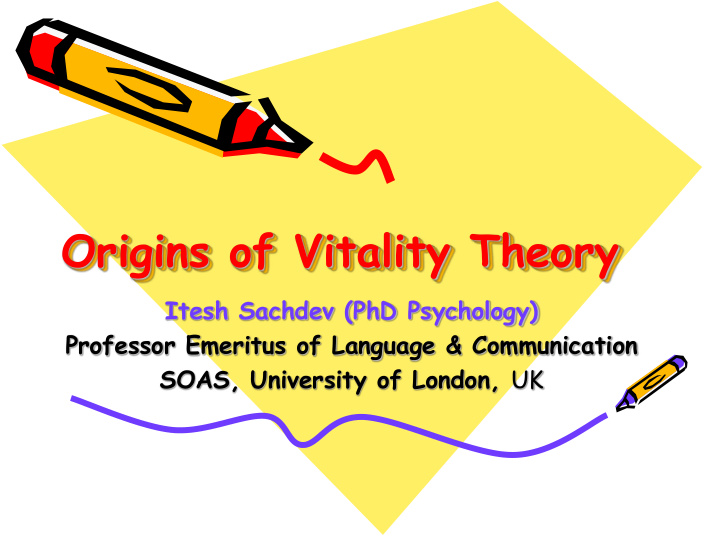



Origins of Vitality Theory Itesh Sachdev (PhD Psychology) Professor Emeritus of Language & Communication SOAS, University of London, UK
Plan • Introduction – what‟s missing..? • Language & identity video… • Ethnolinguistic Vitality..definitions.. • Subjective Vitality Questionnaire (SVQ) • Concluding Notes..
Concluding Remarks from before… (i) Attitude heirarchies are difficult to change (ii) Adopt multi-methodological approaches (iii) Attitudes and Identity linked… (iv) Identity – Key for Language Maintenance & Revitalisation: focus on Self-Determination & Rejection of Imposed Categorizations. (v) Relationship between language, attitudes and group identity is not static.. Hmmmmm…Whats missing in presentation and analyses so far… ? After the break..?
Concluding Remarks (i) Attitude heirarchies are difficult to change – because of existing power and status of groups in society (ii) Attitudes and Identity linked … as a function of power and status differences between groups.. (iii) Identity – Key for Language Maintenance & Revitalisation: focus on Self-Determination & Rejection of Imposed Categorizations … more powerful minorities are better able to do this..ie c ontextualise in terms of the economic, social, political & environmental empowerment of minorities (iv) Relationship between language, attitudes and group identity is not static; it varies as a function of power and status differences…
Missing in previous frameworks/ models/ analyses on identity & language.. Analyses of socio-structural variables like power, status, demography since they have clear effects on intergroup behaviour…
Filling the sociostructual lacuna… • Power, status and other demographic variables.. ie.. sociostructual variables have clear effects on intergroup behaviour… (my PhD research also demonstrated with experimental approach – „the role of power and status in “minimal” minority - majority relations‟). • Giles, Bourhis & Taylor (1977) proposed the notion of „ethnolinguistic vitality‟ to fill the sociostructural lacuna in analyses of integroup relations.
Definition of Ethnolinguistic Vitality That which.. …“makes a group likely to behave as a distinctive and active collective entity in intergroup situations.” (Giles, Bourhis & Taylor 1977: 308).
Factors underlying Ethnolinguistic Vitality https://screenshots.firefox.com/9QD 64FRxBGcFCZce/www.researchgate.ne t Link to Bourhis et al (1981) original SVQ..
Factors underlying Ethnolinguistic Vitality (i) Demographic factors relate to: …“sheer numbers … and their distribution …in urban, regional or national territory…” -numbers: absolute, birthrate, mixed marriages, immigration, emigration - distribution: concentration and proportion
Factors underlying Ethnolinguistic Vitality (ii) Status factors relate to: …group‟s “…economic wealth, social status, socio-historical prestige, status of group language” - Economic status, social status, sociohistorical status, language status inside and outside group.
Factors underlying Ethnolinguistic Vitality (iii) Institutional Support and Control factors relate to: … “…the extent to which language group enjoys formal and informal representation in the various institutions...” - in mass media, education, government services, industry, religion, culture, politics…
Vitality and measurement.. • How can we measure ethnolinguistic vitality…? • … discussion in small groups..?
Factors underlying Ethnolinguistic Vitality https://screenshots.firefox.com/9QD 64FRxBGcFCZce/www.researchgate.ne t Link to Bourhis et al (1981) original SVQ..
Vitality and measurement.. (i) „Objective‟ and „Subjective‟ (ii) Measurement: - Official statistics and data for „objective‟? - Subjective Vitality Questionnaire (Bourhis et al 1981)…?
Examples of SVQ questions… Demographic : “Estimate the proportion of population in Warsaw of the following groups:- People of Polish descent 0%__:__:__:__:__100% People of Gujarati descent 0%__:__:__:__:__100% “To what extent do the following marry only within their own groups:- People of Polish descent Not at all__:__:__:__:__exclusively People of Gujarati descent Not at all__:__:__:__:__exclusively
Examples of SVQ questions… Status: How highly regarded are the following languages in Warsaw:- Polish not at all__:__:__:__:__extremely highly Punjabi not at all__:__:__:__:__extremely highly How proud of their cultural history and achievements are the following groups in Warsaw?:- People of Polish descent Not at all__:__:__:__:__extremely People of Punjabi descent Not at all__:__:__:__:__extremely
Examples of SVQ questions… Institutional Support and Control: How well-represented are the following languages in Warsaw mass media?:- Polish not at all__:__:__:__:__extremely well Mandarin not at all__:__:__:__:__extremely well How well-represented are the following groups in the cultural life of Warsaw?:- People of Polish descent Not at all__:__:__:__:__extremely well People of Chinese descent Not at all__:__:__:__:__extremely well
Findings of early studies using SVQ… (was Bourhis&Sachdev 1981 italian-canadian study the first empirical SVQ study, Martin? ) (i) Objective did not always match subjective – there were systematic biases (eg generational and other group differences) (ii)SV was related systematically to language attitudes and self-reported use.. Amongst italian canadians, cantonese chinese in uk and canada..etc .
Then EXCITING research with the BEVQ - Allard and Landry…early 1990s..) BEVQ: Beliefs about Ethnolinguistic Vitality are better predictors…not just “simple -one- shot” SVQ… beliefs in terms of general (as SVQ), + normative (“should be..”) + personal beliefs + Goal beliefs.. Is BEVQ better at predicting language maintenance and other ethnolinguistic behaviours than SVQ..? … on to Professor Martin Ehala…
MACRO INTERGROUP EVALUATION & CONTEXT BEHAVIOUR SOCIAL - speech PSYCHOLOGICAL - Ethnolinguistic vitality of accommodation PROCESSES groups - discourse - Non-verbal - Social identification -State language policies - & Ideologies -Similarity-Attraction - Stability, legitimacy of - Social Exchange intergroup stratification Additive- - Social Attribution Subtractive Multilingualism & - Intelligibility Multiculturalism - Predictability - Stereotyping MICRO SOCIOLINGUISTIC - Vitality Beliefs SETTING - Acculturation Beliefs - Norms & rules - Networks of linguistic Language & Culture contact Maintenance & Shift Model of Multilingual Communication, Sachdev, Giles & Pauwels, 2012
Recommend
More recommend